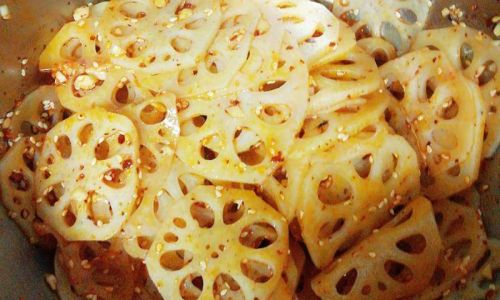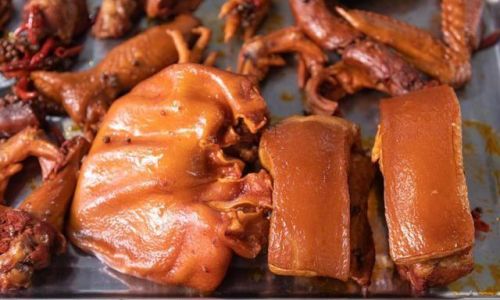Introduction
In the vast culinary landscape of global flavors, spicy dishes hold a special place, captivating taste buds with their fiery heat and complex seasoning. Among the myriad of spicy delicacies, spicy lotus root chips stand out as a unique and delightful snack, blending the crispiness of fried or baked chips with the earthy sweetness of lotus root and the fiery kick of spices. Whether you’re a seasoned chef or a home cook eager to explore new recipes, learning how to make spicy lotus root chips can be a rewarding culinary adventure.
This comprehensive guide will take you through every step of the process, from selecting the perfect lotus root to crafting a spicy seasoning blend that will elevate your snack to new heights. By the end, you’ll have a batch of homemade spicy lotus root chips that are not only delicious but also a testament to your culinary prowess.
Chapter 1: Understanding Lotus Root
Before diving into the recipe, it’s crucial to understand the star ingredient: lotus root. Also known as “renkon” in Japanese or “lian ou” in Chinese, lotus root is a versatile vegetable derived from the rhizome of the lotus plant. It boasts a unique texture, with holes running lengthwise through its cylindrical shape, and a flavor that is subtly sweet and slightly nutty.

1 Nutritional Benefits
Lotus root is not just a delightful addition to meals; it’s also packed with nutritional benefits. It’s a good source of dietary fiber, which aids in digestion, and contains essential vitamins and minerals such as vitamin C, iron, and copper. Its low-calorie content makes it an ideal choice for those watching their weight.
2 Selecting and Storing Lotus Root
When choosing lotus root, look for firm, unblemished pieces with clean, fresh cuts. Avoid those that are soft, discolored, or have mold. Fresh lotus root can be stored in the refrigerator for up to a week, wrapped in plastic wrap or placed in an airtight container. For longer storage, you can freeze it, sliced or whole, for up to three months.
Chapter 2: Preparing the Lotus Root
Now that you’re familiar with lotus root, let’s move on to preparing it for your spicy chips.
1 Cleaning and Peeling
Start by thoroughly washing the lotus root under running water to remove any dirt or debris. Use a vegetable peeler to remove the outer skin, which can be tough and slightly bitter. Once peeled, inspect the flesh for any dark spots or imperfections and trim them away.
2 Slicing the Lotus Root
For chips, you’ll want to slice the lotus root into thin, even rounds. Aim for a thickness of about 1/8 to 1/4 inch (3 to 6 mm). A sharp knife or mandoline slicer will make this task easier and ensure more uniform slices. If you prefer thicker chips, feel free to adjust the thickness, but remember that thinner slices will crisp up faster.
3 Soaking (Optional)
Some recipes recommend soaking the sliced lotus root in water for a few minutes to remove excess starch, which can help prevent the chips from becoming too sticky or gummy during cooking. However, this step is optional and depends on your personal preference and the cooking method you choose.
Chapter 3: Cooking Methods
There are several ways to cook lotus root chips, each yielding a slightly different texture and flavor. Here, we’ll explore two popular methods: frying and baking.
1 Frying Method
1.1 Preparing the Oil
Fill a deep fryer or a large, heavy-bottomed pot with enough vegetable oil to fully submerge the lotus root slices. Choose an oil with a high smoking point, such as peanut, canola, or grapeseed oil. Heat the oil to 350°F (175°C).
1.2 Frying the Chips
Working in batches to avoid overcrowding, carefully lower the lotus root slices into the hot oil using a slotted spoon or frying basket. Fry for about 2-3 minutes, or until golden brown and crispy. Use a thermometer to monitor the oil temperature and adjust the heat as needed to maintain a consistent temperature.
1.3 Draining and Cooling
Once done, remove the chips from the oil and let them drain on paper towels or a wire rack. Allow them to cool slightly before seasoning, as they will continue to crisp up as they cool.
2 Baking Method
2.1 Preheating the Oven
Preheat your oven to 400°F (200°C). Line a baking sheet with parchment paper or a silicone baking mat to prevent sticking.
2.2 Preparing the Chips
Arrange the lotus root slices in a single layer on the prepared baking sheet. Lightly brush or spray them with oil to help them crisp up during baking. You can use olive oil, avocado oil, or any other oil you prefer.

2.3 Baking the Chips
Bake for about 15-20 minutes, flipping the slices halfway through to ensure even cooking. Keep a close eye on them to prevent burning. They should be golden brown and crispy when done.
2.4 Cooling
Allow the baked chips to cool on the baking sheet for a few minutes before transferring them to a wire rack to cool completely. This will help them crisp up further.
Chapter 4: Crafting the Spicy Seasoning Blend
The key to making delicious spicy lotus root chips lies in the seasoning. Here, we’ll create a versatile spicy seasoning blend that you can customize to your taste preferences.
1 Basic Ingredients
- Salt: To enhance flavor.
- Pepper: Black pepper or white pepper, for a bit of heat and depth.
- Red Pepper Flakes: For a fiery kick.
- Garlic Powder: To add a savory, aromatic note.
- Onion Powder: For a hint of sweetness and onion flavor.
- Paprika: Smoked paprika adds a smoky flavor and a touch of heat.
- Cumin: For a warm, earthy taste.
- Chili Powder: For additional heat and complexity.
- Sesame Seeds: Toasted sesame seeds add crunch and a nutty flavor.
- Cilantro or Parsley: Fresh herbs for a burst of freshness (optional).
2 Customizing the Blend
Feel free to adjust the quantities of each ingredient to suit your taste. If you prefer less heat, reduce the amount of red pepper flakes and chili powder. For a smokier flavor, increase the smoked paprika. You can also add other spices like coriander, turmeric, or even a pinch of cayenne pepper for extra heat.
3 Combining the Ingredients
In a small bowl, mix together the salt, pepper, red pepper flakes, garlic powder, onion powder, paprika, cumin, and chili powder. Toast the sesame seeds in a dry pan over medium heat until golden brown, then add them to the spice mix. Stir well to combine.
Chapter 5: Seasoning and Serving
Now that your lotus root chips are cooked and your seasoning blend is ready, it’s time to bring them together.
1 Seasoning the Chips
Place the cooked and cooled lotus root chips in a large bowl. Sprinkle the seasoning blend over the chips, tossing gently to ensure even coating. If using fresh herbs, chop them finely and sprinkle over the top.
2 Serving Suggestions
Spicy lotus root chips are a versatile snack that can be enjoyed on their own or paired with various dips and drinks. Here are a few serving suggestions:
- Dipping Sauces: Try them with a tangy yogurt dip, a spicy sriracha mayo, or a classic hummus.
- Appetizer Platter: Serve them as part of a diverse appetizer platter with other snacks like veggie sticks, cheese cubes, and nuts.
- Drinks: Pair them with a refreshing iced tea, a crisp beer, or a spicy cocktail like a Bloody Mary.
Chapter 6: Storage and Reheating
If you have leftovers or want to make a batch ahead of time, here’s how to store and reheat your spicy lotus root chips.
1 Storage
Store any leftover chips in an airtight container at room temperature for up to a day. For longer storage, place them in an airtight container and refrigerate for up to three days. They can also be frozen for up to a month, but their texture may change slightly upon reheating.
2 Reheating
To reheat, place the chips on a baking sheet and bake at 350°F (175°C) for about 5-7 minutes, or until crispy. Alternatively, you can reheat them in a toaster oven or even microwave them for a short burst, but be careful not to overheat as they can become soggy.
Conclusion
Making spicy lotus root chips





0 comments